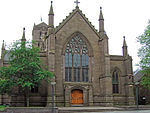Overgate Centre

The Overgate Centre is a shopping centre in Dundee, Scotland. Built in the 1960s to replace buildings erected in the 18th and 19th centuries, most of the original structure (e.g. the Angus Hotel) was demolished and redeveloped from 1998 to 2000. The centre reopened as a fully enclosed shopping mall in 2000 and follows the same basic layout as the 1960s structure. Two levels of retail units are enclosed by a long curved glass elevation looking out to the historic City Churches where a pedestrian precinct remains. It houses over 60 shops, cafes and restaurants as well as three car parks, two being multi-storey. The flagship stores are Debenhams, which is the only store that spans three floors, situated at the west end, and Primark at the opposite end. City House, a ten-storey office building, is located within the Overgate Centre itself and remains from the original 1960s centre. It overlooks the pedestrianised City Square and historic Caird Hall. City House is home to the Dundee offices of Curtis Banks, which employs around 40 members of staff.
Excerpt from the Wikipedia article Overgate Centre (License: CC BY-SA 3.0, Authors, Images).Overgate Centre
Union Street, Dundee City Centre
Geographical coordinates (GPS) Address Phone number Website External links Nearby Places Show on map
Geographical coordinates (GPS)
| Latitude | Longitude |
|---|---|
| N 56.459 ° | E -2.9741 ° |
Address
Overgate Shopping Centre
Union Street
DD1 1UQ Dundee, City Centre
Scotland, United Kingdom
Open on Google Maps








